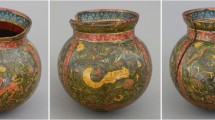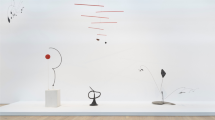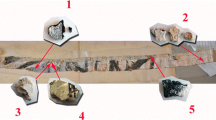Abstract
Alberto Burri (1915–1995) was a pioneering Italian painter and sculptor. Born in Città di Castello, a small town in the region of Umbria, he earned a medical degree from the University of Perugia. While serving in the Ethiopian campaign and in World War II, first as a frontline soldier and then as a physician, he was captured and sent to a prisoner-of-war camp in Hereford, Texas. It was there that Burri disavowed the medical profession and began to paint. He held a pivotal position in the modern post-war era, exhibiting in Rome and New York in the early 1950s. The present article describes an in-depth scientific investigation of a selection of 14 paintings by Burri, each belonging to one of his series: Sacchi (sacks), Bianchi (whites), Catrami (tars), Muffe (molds), Gobbi (hunchbacks), Legni (woods), Combustioni plastiche (plastic combustions), Ferri (irons), Cretti (monochromatic fields of induced craquelure), and Cellotex (compositions on flayed fiberboard). Elemental information obtained non-invasively via X-ray fluorescence (XRF) spectroscopy was here combined with detailed characterization of the pigments, extenders, binders, and plastics by means of micro-invasive techniques, including pyrolysis–gas chromatography/mass spectrometry (Py-GC/MS), Fourier-transform infrared (FTIR) and Raman spectroscopies, and scanning electron microscopy/energy-dispersive X-ray (SEM/EDX) spectroscopy. Through the joint use of traditional artists’ materials along with industrial products newly introduced to the market, Burri appears to have encapsulated space into highly dramatic compositions at the boundaries between painting and relief sculpture.









Similar content being viewed by others
References
E. Braun, Alberto Burri: The Trauma of Painting (Guggenheim Museum Publications, New York, 2015)
F. Rosi, C. Miliani, C. Clementi, K. Kahrim, F. Presciutti, M. Vagnini, V. Manuali, A. Daveri, L. Cartechini, B.G. Brunetti, A. Sgamellotti, Appl. Phys. A 100(3), 613 (2010)
F. Rosi, G. De Cesare, P. Iazurlo, A. Daveri, M. Vagnini, F. Valentini, G. Basile, in Science and Art: The Painted Surface, ed. by A. Sgamellotti, B.G. Brunetti, C. Miliani (Royal Society of Chemistry, Cambridge, 2014), pp. 499–521
F. Rosi, C. Miliani, R. Braun, R. Harig, D. Sali, B.G. Brunetti, A. Sgamellotti, Angew. Chem. Int. Ed. 52, 1 (2013)
S.L. Silbert, W.S. Port, J. Am. Oil Chem. Soc. 34, 9 (1957)
M.F. Silva, M.T. Doménech-Carbó, L. Fuster-López, M.F. Mecklenburg, S. Martin-Rey, Anal. Bioanal. Chem. 397, 357 (2010)
M.R. Schilling, J. Mazurek, T.J. Learner, in Modern Paints Uncovered: Proceedings from the Modern Paints Uncovered Symposium, ed. by T.J. Learner, P. Smithen, J.W. Krueger, M.R. Schilling (Getty Publications, Los Angeles, 2007)
H.A. Standeven, House Paints, 1900–1960: History and Use (Getty Publications, Los Angeles, 2011)
T. Learner, Stud. Conserv. 46, 225 (2001)
C.V. Horie, Materials for Conservation. Organic Consolidants Adhesives and Coatings (Butterworths, London, 1987), pp. 93–101
T. Learner, in Resins Ancient and Modern, ed. by M.M. Wright, J.H. Towsend (Scottish Society for Conservation and Restoration, Edinburgh, 1995), pp. 76–77
M.T. Doménech-Carbó, G. Bitossi, L. Osete-Cortina, J. Cruz-Cañizares, D.J. Yusá-Marco, Anal. Bioanal. Chem. 391, 1371 (2007)
M.F. Silva, M.T. Doménech-Carbó, L. Fuster-López, S. Martin-Rey, M.F. Mecklenburg, J. Anal. Appl. Pyrolysis 85, 487 (2009)
P. Gottschaller, N. Khandekar, L.F. Lee, P.D. Kirby, Stud. Cons. 57, 76 (2012)
A. Spazzoli, T. Tiziani, in Arti Grafiche Beta (Cologno Monzese, 2008). http://www.vinavil.com/FlipPage/EN/FlipPageStoria.htm. Accessed 6 Sep 2016
D. Swern, E.F. Jordan, J. Am. Chem. Soc. 70, 2334 (1948)
E. R. Bertram, W. G. Kunze, Polyvinyl acetate emulsion containing an aliphatic carboxylic acid, and base coated therewith (Google Patents, 1952). http://www.google.com/patents/US2595954)
H.M. Teeter, J. Am. Oil Chem. Soc. 40, 143 (1963)
K. Ruyter, H. A. Oosterhof, Polyvinyl ester emulsions containing alpha-branched, saturated, aliphatic monocarboxylic acid salts (1967, Google Patents). http://www.google.com/patents/US3342765)
K.J. Van den Berg, M. Geldof, S. de Groot, H. van Keulen, ICOM-CC 13th triennial meeting, Rio de Janeiro (International Council of Museums, Paris, 2002), pp. 464–472
M. Kokkori, K. Sutherland, J. Boon, F. Casadio, M. Vermeulen, Herit Sci 3, 1 (2015)
O. Zovi, L. Lecamp, C. Loutelier-Bourhis, C.M. Lange, C. Bunel, Eur. J. Lipid Sci. Technol. 113, 616 (2011)
G.M. Languri, J. Anal. Appl. Pyrolysis 63, 171 (2002)
S.C. Moldoveanu, Analytical Pyrolysis of Synthetic Organic Polymers, vol. 25 (Elsevier, Amsterdam, 2005), pp. 281–283
Acknowledgments
We are grateful to MAPEI for financial support. Emily Braun (Hunter College and the Graduate Center, CUNY), Megan Fontanella and Ylinka Barotto (Solomon R. Guggenheim Museum) are also acknowledged for their contribution to the curatorial research on Burri.
Author information
Authors and Affiliations
Corresponding author
Rights and permissions
About this article
Cite this article
Pozzi, F., Arslanoglu, J., Carò, F. et al. Conquering space with matter: a technical study of Alberto Burri’s materials and techniques. Appl. Phys. A 122, 917 (2016). https://doi.org/10.1007/s00339-016-0435-7
Received:
Accepted:
Published:
DOI: https://doi.org/10.1007/s00339-016-0435-7




